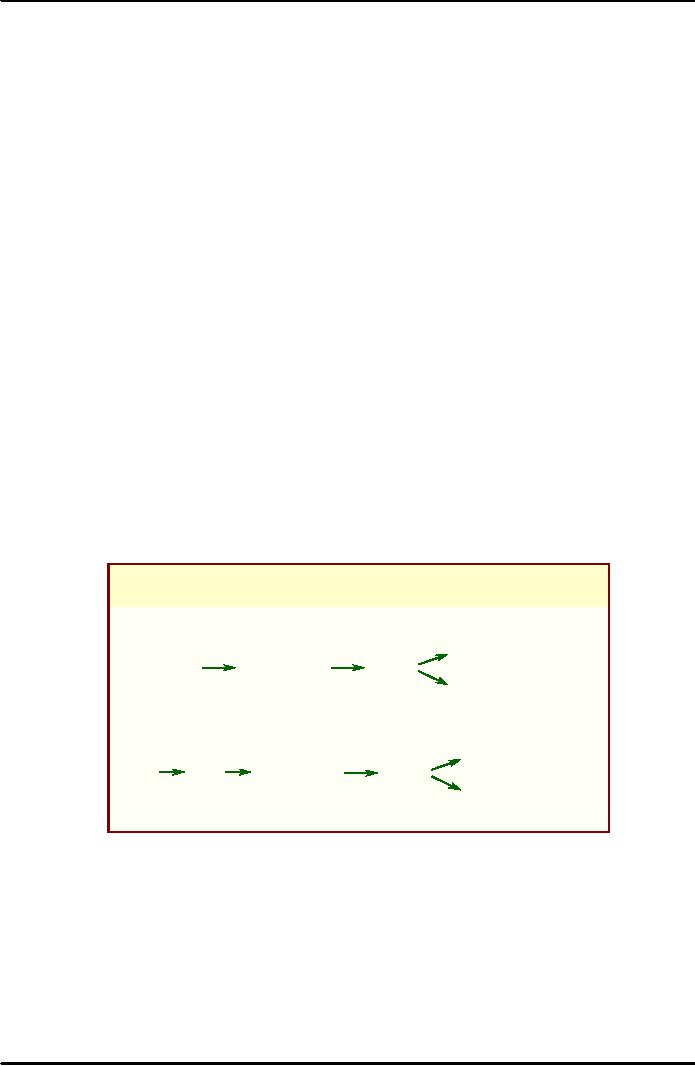 |
INTRODUCTION TO ECONOMICS (CONTINUED………):Opportunity Cost |
| << INTRODUCTION TO ECONOMICS:Economic Systems |
| DEMAND, SUPPLY AND EQUILIBRIUM:Goods Market and Factors Market >> |

Introduction
to Economics ECO401
VU
Lesson
1.2
INTRODUCTION
TO ECONOMICS
(CONTINUED.........)
Optimum
means
producing the best possible
results (also
optimal).
Equity
in economics means a
situation in which every
thing is treated fairly or
equally, i.e.
according
to its due share. So if the
lives of all individuals are
deemed to have equal
value,
equity
would demand that all of
them have equal financial
net worth.
Nepotism
means
doing unfair favors for
near ones when in
power.
Microeconomics
and Macroeconomics:
Microeconomics
deals with the behavior of
individual elements in the
economy.
Macroeconomics
deals with the behavior of
the economy as whole or on
aggregate level.
Rational
choice is the
choice based on pure reason
and without succumbing to
one's
emotions
or whims.
Barter
trade is a
non-monetary system of trade in
which "goods" not money is
exchanged.
This
was the system used in
the world before the
advent of coins and
currency.
Opportunity
Cost:
The
opportunity cost of a particular
choice is the satisfaction
that would have been
derived
from
the next best alternative
foregone; in other words, it is
what must be given up
or
sacrificed
in making a certain choice or
decision.
Marginal
Cost and Marginal
Benefit:
Marginal
cost is the increment to
total costs of producing an
additional unit of some good
or
service.
There are other broader
definitions as well.
Marginal
benefit is the increment to
total benefit derived from
consuming an additional unit
of
good
or service. There are other
broader definitions as
well.
Production
Possibility Frontier
(PPF):
Production
possibility frontier (PPF) is
the curve which joins
all the points showing
the
maximum
amount of goods and services
which the country can
produce in a given time
with
limited
resources, given a specific
state of technology.
Economic
growth is an increase
in the total output of a
country over time.
2

Introduction
to Economics ECO401
VU
END
OF UNIT 1 - EXERCISES
Could
production and consumption
take place without money? If
you think they
could,
give
examples.
Yes.
People could produce things
for their own consumption.
For example, people could
grow
vegetables
in their garden or allotment;
they could do their own
painting and
decorating.
Alternatively
people could engage in
barter: they could produce
things and then swap
them for
goods
that other people had
produced.
Must
goods be at least temporarily
unattainable to be scarce?
Goods
need not be unattainable to be
scarce. Because people's
incomes are limited, they
can
not
have everything they want
from shops, even though
the shops are stocked
full. If all items in
shops
were free, the shelves
would soon be
emptied!
If
we would all like more
money, why does the
government not print a lot
more? Could it
not
thereby solve the problem of
scarcity `at a
stroke'?
The
problem of scarcity is one of a
lack of production. Simply
printing more money
without
producing
more goods and services
will merely lead to
inflation. To the extent
that firms cannot
meet
the extra demand (i.e.
the extra consumer
expenditure) by extra production,
they will
respond
by putting up their prices.
Without extra production,
consumers will be unable to
buy
any
more than previously.
Which
of the following are
macroeconomic issues, which
are microeconomic ones
and
which
could be either depending on
the context?
a)
Inflation.
b)
Low wages in certain service
industries.
c)
The rate of exchange between
the dollar and the
rupee.
d)
Why the price of cabbages
fluctuates more than that of
cars.
e)
The rate of economic growth
this year compared with
last year.
f)The
decline of traditional manufacturing
industries.
a)
Macro. It refers to a general
rise in prices across the
whole economy.
b)
Micro. It refers to specific
industries
c)
Either. In a world context, it is a
micro issue, since it refers
to the price of one
currency
in terms of one other. In a
national context it is more of a
macro issue,
since
it refers to the exchange
rate at which all Pakistanis
goods are traded
internationally.
(This is certainly a less
clearcut division that in
(a) and (b)
above.)
d)
Micro. It refers to specific
products.
e)
Macro. It refers to the
general growth in output of
the economy as a
whole.
f)Micro
(macro in certain contexts). It is
micro because it refers to
specific industries. It
could,
however, also help to
explain the macroeconomic
phenomena of high
unemployment
or balance of payments
problems.
Assume
that you are looking
for a job and are
offered two. One is more
unpleasant to do,
but
pays more. How would
you make a rational choice
between the two
jobs?
You
should weigh up whether the
extra pay (benefit) from
the better paid job is
worth the extra
hardship
(cost) involved in doing
it.
How
would the principle of
weighing up marginal costs
and benefits apply to a
worker
deciding
how much overtime to work in
a given week?
The
worker would consider
whether the extra pay
(the marginal benefit) is
worth the extra
effort
and
loss of leisure (the
marginal cost).
3

Introduction
to Economics ECO401
VU
Would
it ever be desirable to have
total equality in an
economy?
The
objective of total equality
may be regarded as desirable in
itself by many people. There
are
two
problems with this
objective, however. The
first is in defining equality. If
there were total
equality
of incomes then households
with dependants would have a
lower income per head
than
households
where everyone was working.
In other words, equality of
incomes would not
mean
equality
in terms of standards of
living.
If
on the other hand, equality
were to be defined in terms of
standards of living, then
should the
different
needs of different people be
taken into account? Should
people with special health
or
other
needs have a higher income?
Also, if equality were to be
defined in terms of standards
of
living,
many people would regard it
as unfair that people should
receive different
incomes
(according
to the nature of their
household) for doing the
same amount of work.
The
second major problem
concerns incentives. If all
jobs were to be paid the
same (or people
were
to be paid according to the
composition of their household),
irrespective of people's
efforts
or
skills, then what would be
the incentive to train or to
work harder?
If
there are several other
things you could have
done, is the opportunity
cost the sum of
all
of them?
No.
It is the sacrifice involved in
the next best
alternative.
What
is the opportunity cost of
spending an evening revising
for an economics
exam?
What
would you need to know in
order to make a sensible
decision about what to do
that
evening?
The
next best alternative might
be revising for another
exam, or it might be taking
time off to
relax
or to go out. To make a sensible
decision, you need to
consider these alternatives
and
whether
they are better or worse
for you than studying
for the economics exam.
One major
problem
here is the lack of
information. You do not know
just how much the
extra study will
improve
your performance in the
exam, because you do not
know in advance just how
much you
will
learn and you do not
know what is going to be on
the exam paper. Similarly
you do not
know
this information for
studying for other
exams.
Make
a list of the benefits of
higher education.
The
benefits to the individual
include: increased future
earnings; the direct
benefits of being
more
educated; the pleasure of
the social contacts at
university or college.
Is
the opportunity cost to the
individual of attending higher
education different from
the
opportunity
costs to society as a
whole?
Yes.
The opportunity cost to
society as a whole would
include the costs of
providing tuition
(staffing
costs, materials, capital
costs, etc.), which could be
greater than any fees
the student
may
have to pay. On the other
hand, the benefits to
society would include
benefits beyond those
received
by the individual. For
example, they would include
the extra profits employers
would
make
by employing the individual
with those
qualifications.
There
is a saying in economics, `There is no
such thing as a free lunch'
(hence the sub-
title
for this box). What
does this mean?
That
there is always (or
virtually always) an opportunity
cost of anything we consume.
Even if
we
do not incur the cost
ourselves (the `lunch' is
free to us), someone will
incur the cost (e.g.
the
institution
providing the lunch).
Are
any other (desirable) goods or
services truly
abundant?
Very
few! Possibly various social
interactions between people,
but even here, the
time to enjoy
them
is not abundant.
4

Introduction
to Economics ECO401
VU
Under
what circumstances would the
production possibility curve be
(a) a straight
line;
(b)
bowed in toward the origin?
Are these circumstances ever
likely?
a)
When there are constant
opportunity costs. This will
occur when resources are
equally
suited
to producing either good.
This might possibly occur in
our highly simplified
world
of
just two goods. In the
real world it is
unlikely.
b)
When there are decreasing
opportunity costs. This
will occur when
increased
specialization
in one good allows the
country to become more
efficient in its
production.
It
gains `economies of scale'
sufficient to offset having to
use less suitable
resources.
Will
economic growth necessarily
involve a parallel outward
shift of the
production
possibility
curve?
No.
Technical progress, the
discovery of raw materials,
improved education and
training, etc.,
may
favour one good rather
than the other. In such
cases the gap between
the old and
new
curves
would be widest where they
meet the axis of the
good whose potential output
had grown
more.
Do
you agree with the
positions that the eight
countries (including Pakistan)
have been
given
in the economics systems
spectrum diagram? Explain why or why
not.
Given
that there is no clearly
defined scale by which
government intervention or
free-marketness
is
measured, the precise
position of the countries
along the spectrum is open
to question.
Can
you think of any examples
where prices and wages do
not adjust very rapidly to
a
shortage
or surplus? For what reasons
might they not do
so?
Many
prices set by companies are
adjusted relatively infrequently: it
would be
administratively
too costly to change them
every time there was a
change in demand.
For
example a mail order
company, where all the
items in its catalogue have
a printed
price,
would find it costly to
adjust prices very
frequently, since that would
involve printing
a
new catalogue, or at least a
new price list.
Many
wages are set annually by a
process of collective bargaining.
They are not
adjusted
in
the interim.
Why
do the prices of fresh
vegetables fall when they
are in season? Could an
individual
farmer
prevent the price
falling?
Because
supply is at a high level.
The increased supply creates
a surplus which pushes
down
the
price. Individual farmers
could not prevent the
price falling. If they
continued to charge
the
higher
price, consumers would
simply buy from those
farmers charging the lower
price.
If
you were the owner of a
clothes shop, how would
you set about deciding
what prices to
charge
for each garment at the
end of season
sale?
You
would try to reduce the
price of each item as little
as was necessary to get rid
of the
remaining
stock. The problem for
shop owners is that they do
not have enough
information
about
consumer demand to make
precise calculations here.
Many shops try a fairly
cautious
approach
first, and then, if that is
not enough to sell all
the stock, they make
further `end of sale'
reductions
later.
The
number of owners of CD players
has grown rapidly and
hence the demand for
CDs
has
also grown rapidly. Yet
the prices of CDs have
fallen. How could this
come about?
�
The
costs of manufacturing CDs
may have fallen with
improvements in technology
and
mass-production
economies.
�
Competition
from increased numbers of
manufacturers may have
increased supply of
CDs
and
driven prices down.
5

Introduction
to Economics ECO401
VU
�
The advent of
copying tracks from the
internet reduces the demand
for CDs. This
change
in
demand has further
compounded the fall in
price.
Which
of the following are
positive statements, which
are normative statements
and
which
could be either depending on
the context?
a)
Cutting the higher rates of
income tax will redistribute
incomes from the
poor
to the rich.
b)
It is wrong that inflation
should be reduced if this
means that there will
be
higher
unemployment.
c)
It is wrong to state that
putting up interest rates
will reduce
inflation.
d)
The government should raise
interest rates in order to
prevent the
exchange
rate falling.
e)
Current government policies
should reduce
unemployment.
a)
Positive. This is merely a
statement about what would
happen.
b)
Normative. The statement is
making the value judgment
that reducing inflation is a
less
desirable
goal than the avoidance of
higher unemployment.
c)
Positive. Here the word
`wrong' means `incorrect'
not `morally wrong'. The
statement is
making
a claim that can be tested
by looking at the facts. Do
higher interest rates
reduce
inflation,
or don't they?
d)
Both. The positive element
is the claim that higher
interest rates prevent the
exchange
rate
falling. This can be tested
by an appeal to the facts.
The normative element is
the
value
judgment that the government
ought to prevent the
exchange rate
falling.
e)
Either. It depends what is
meant. If the statement
means that current
government
policies
are likely to reduce
unemployment, the statement is
positive. If, however,
it
means
that the government ought to
direct its policies towards
reducing unemployment,
the
statement is normative.
Explain
in words what is happening in
the following
diagram.
T
h e p r ic e m e c h a n is m : th e e f fe c t o f th e d is c o v e r y o f r
a w m a te r ia ls
F
a c to r M a rk e t
Si ↓
Si ↑
Pi ↓
s
u rp lu s
u
n t il D
i =
S i
(
S
i > D i)
Di ↑
G
o o d s M a rk e t
Sg ↓
Pi ↓
Sg ↑
Pg ↓
s
u rp lu s
u
n t il D
g =
S g
(S
g > D g)
Dg ↑
The
new discovery of raw
material i means an increase in
the supply i. This causes a
surplus
(excess
supply) in the market for i,
causing the price of i to
fall until the same is
removed (lower
Pi
causes demand to increase
and supply to fall). The
reduction in Pi also reduces
the cost of
producing
good g (we can assume
good g uses the factor i
intensively), causing the
supply of
good
g to increase beyond demand.
The surplus in the market
for good g drives the
price of g
down
until the excess is cleared.
The diagram illustrates
interdependence between goods
and
factor
markets.
Can
different factor markets be
interdependent also? Give
examples.
Yes.
A rise in the price of one
factor (e.g. oil) will
encourage producers to switch to
alternatives
(e.g.
coal). This will create a
shortage of coal and drive
up its price. This will
encourage
6

Introduction
to Economics ECO401
VU
increased
production of coal. Similarly an
increase in the population
(and consequently size
of
the
labour force) of a country
will depress the price of
labour (wages). This will
cause producers
to
shift to more labour
intensive production and
reduce production methods
which are capital
(or
machine)
intensive. As a result the
demand for capital will
fall reducing its rental
price.
7
Table of Contents:
- INTRODUCTION TO ECONOMICS:Economic Systems
- INTRODUCTION TO ECONOMICS (CONTINUED………):Opportunity Cost
- DEMAND, SUPPLY AND EQUILIBRIUM:Goods Market and Factors Market
- DEMAND, SUPPLY AND EQUILIBRIUM (CONTINUED……..)
- DEMAND, SUPPLY AND EQUILIBRIUM (CONTINUED……..):Equilibrium
- ELASTICITIES:Price Elasticity of Demand, Point Elasticity, Arc Elasticity
- ELASTICITIES (CONTINUED………….):Total revenue and Elasticity
- ELASTICITIES (CONTINUED………….):Short Run and Long Run, Incidence of Taxation
- BACKGROUND TO DEMAND/CONSUMPTION:CONSUMER BEHAVIOR
- BACKGROUND TO DEMAND/CONSUMPTION (CONTINUED…………….)
- BACKGROUND TO DEMAND/CONSUMPTION (CONTINUED…………….)The Indifference Curve Approach
- BACKGROUND TO DEMAND/CONSUMPTION (CONTINUED…………….):Normal Goods and Giffen Good
- BACKGROUND TO SUPPLY/COSTS:PRODUCTIVE THEORY
- BACKGROUND TO SUPPLY/COSTS (CONTINUED…………..):The Scale of Production
- BACKGROUND TO SUPPLY/COSTS (CONTINUED…………..):Isoquant
- BACKGROUND TO SUPPLY/COSTS (CONTINUED…………..):COSTS
- BACKGROUND TO SUPPLY/COSTS (CONTINUED…………..):REVENUES
- BACKGROUND TO SUPPLY/COSTS (CONTINUED…………..):PROFIT MAXIMISATION
- MARKET STRUCTURES:PERFECT COMPETITION, Allocative efficiency
- MARKET STRUCTURES (CONTINUED………..):MONOPOLY
- MARKET STRUCTURES (CONTINUED………..):PRICE DISCRIMINATION
- MARKET STRUCTURES (CONTINUED………..):OLIGOPOLY
- SELECTED ISSUES IN MICROECONOMICS:WELFARE ECONOMICS
- SELECTED ISSUES IN MICROECONOMICS (CONTINUED……………)
- INTRODUCTION TO MACROECONOMICS:Price Level and its Effects:
- INTRODUCTION TO MACROECONOMICS (CONTINUED………..)
- INTRODUCTION TO MACROECONOMICS (CONTINUED………..):The Monetarist School
- THE USE OF MACROECONOMIC DATA, AND THE DEFINITION AND ACCOUNTING OF NATIONAL INCOME
- THE USE OF MACROECONOMIC DATA, AND THE DEFINITION AND ACCOUNTING OF NATIONAL INCOME (CONTINUED……………..)
- MACROECONOMIC EQUILIBRIUM & VARIABLES; THE DETERMINATION OF EQUILIBRIUM INCOME
- MACROECONOMIC EQUILIBRIUM & VARIABLES; THE DETERMINATION OF EQUILIBRIUM INCOME (CONTINUED………..)
- MACROECONOMIC EQUILIBRIUM & VARIABLES; THE DETERMINATION OF EQUILIBRIUM INCOME (CONTINUED………..):The Accelerator
- THE FOUR BIG MACROECONOMIC ISSUES AND THEIR INTER-RELATIONSHIPS
- THE FOUR BIG MACROECONOMIC ISSUES AND THEIR INTER-RELATIONSHIPS (CONTINUED…….)
- THE FOUR BIG MACROECONOMIC ISSUES AND THEIR INTER-RELATIONSHIPS (CONTINUED…….):Causes of Inflation
- THE FOUR BIG MACROECONOMIC ISSUES AND THEIR INTER-RELATIONSHIPS (CONTINUED…….):BALANCE OF PAYMENTS
- THE FOUR BIG MACROECONOMIC ISSUES AND THEIR INTER-RELATIONSHIPS (CONTINUED…….):GROWTH
- THE FOUR BIG MACROECONOMIC ISSUES AND THEIR INTER-RELATIONSHIPS (CONTINUED…….):Land
- THE FOUR BIG MACROECONOMIC ISSUES AND THEIR INTER-RELATIONSHIPS (CONTINUED…….):Growth-inflation
- FISCAL POLICY AND TAXATION:Budget Deficit, Budget Surplus and Balanced Budget
- MONEY, CENTRAL BANKING AND MONETARY POLICY
- MONEY, CENTRAL BANKING AND MONETARY POLICY (CONTINUED…….)
- JOINT EQUILIBRIUM IN THE MONEY AND GOODS MARKETS: THE IS-LM FRAMEWORK
- AN INTRODUCTION TO INTERNATIONAL TRADE AND FINANCE
- PROBLEMS OF LOWER INCOME COUNTRIES:Poverty trap theories: